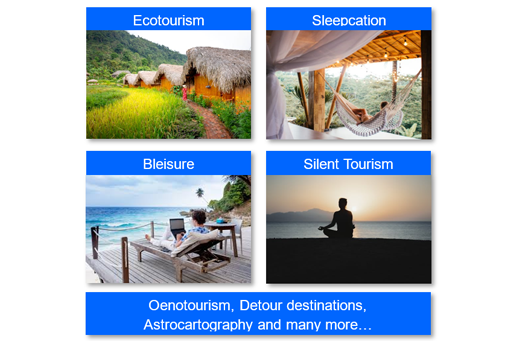 Reading Time: 8 minutes
Reading Time: 8 minutesIntroduction: The new wave of tourism
The tourism industry is undergoing a seismic shift, driven by technological advancements, evolving customer preferences, and the integration of artificial intelligence (AI). In 2024, the global travel and tourism sector contributed an estimated $11.1 trillion to the economy, reflecting its vital role in the global GDP [1]. The noticeable key trends were the increased adoption of AI for personalized travel experiences, the rise of sustainable tourism, and the growing demand for unique, immersive experiences [1].

The experience economy: The background to EAAS
The major factor driving EAAS is the experience economy. In typical terms, the experience economy is a term used to describe the current economy where customers are seeking experiences over products and services. It can be quantified as the economic value of an experience, which is a psychological process people can go through. In the experience economy, customers are willing to pay a premium for unique, memorable experiences.
Examples of premium experiences include:
- Eco-tourism: Sustainable travel options that minimize environmental impact.
- Bleisure: Combining business and leisure travel for a balanced experience.
- Silent tourism: Destinations that offer tranquility and escape from noise.
- Sleepcation: Travel focused on rest and rejuvenation.
- Oenotourism: Wine tourism, exploring vineyards and wine-making processes.
- Detour destinations: Off-the-beaten-path locations offering unique experiences.
- Astrocartography: Travel based on astrological charts and celestial events.

What is Experience as a Service (EAAS)?
Experience as a Service (EAAS) encompasses the delivery of personalized, memorable experiences to travelers, leveraging technology and data to enhance every aspect of their journey. This includes smart recommendations, hyper-personalization, smart itineraries, and many more. Here are some examples:
1. Expedia’s “Travel Yourself Interesting” : Repositioned travel as a valuable investment in personal growth, achieving significant ROI [5].
2. Iceland air’s Iceland Academy: Offered immersive educational experiences to travelers, enhancing engagement and brand loyalty [5].
3. Montana Office of Tourism: Created a mobile tour to promote local cuisine and culture, driving interest in Montana [2].
4. S7 Airlines’ Imagination Machine: Used brainwave technology to offer free tickets, engaging travelers in a unique way [2].
5. Marriott’s Virtual Honeymoon: Provided virtual reality experiences to newlyweds, creating memorable moments [2].
The Future of EAAS
The future of EAAS is bright, with advancements in AI and Augmented Reality (AR) set to revolutionize the industry. By 2030, the metaverse will enable never-ending tourism, where travelers can virtually explore destinations before, during, and after their trips [3]. This integration of digital and physical realities will create seamless, immersive experiences that transcend traditional travel boundaries.
Benefits of EAAS across the tourism industry
EAAS offers numerous benefits for various stakeholders:
- Travelers: Enhanced satisfaction through personalized experiences and smart itineraries.
- Businesses: Increased revenue and customer loyalty by offering unique, memorable experiences.

Some of the KPIs impacted are Customer satisfaction, Net Promoter Score (NPS), and Revenue Per Customer.
Enabling EAAS: Tools and strategies
To successfully implement Experience as a Service (EAAS) in the tourism industry, enterprises must adopt a combination of advanced analytics solutions, AI-powered data analytics, and innovative digital marketing strategies.
Advanced analytics solutions are crucial for transforming raw data into actionable insights. These tools help enterprises understand customer behavior, preferences, and trends, enabling them to tailor experiences that resonate with travelers. Key components include:
- Predictive analytics: By analyzing historical data, predictive analytics can forecast future trends and customer behaviors, allowing businesses to proactively design experiences that meet anticipated needs.
- Real-time analytics: Real-time data processing enables immediate insights into customer interactions, allowing for on-the-fly adjustments to enhance the travel experience.
- Augmented analytics: This involves using Machine Learning (ML) and Natural Language Processing (NLP) to automate data analysis, making it easier for non-technical users to derive insights and make data-driven decisions.

AI-powered data analytics platforms, such as the Fosfor Decision Cloud, play a pivotal role in enabling EAAS by providing deep insights into customer preferences and behaviors. These platforms offer several benefits:
- Hyper-personalization: AI algorithms analyze vast amounts of data to create highly personalized travel experiences, from customized itineraries to tailored recommendations.
- Smart itineraries: AI can optimize travel plans based on real-time data, ensuring that travelers have seamless and enjoyable journeys.
- Actionable data insights: AI-powered insights help businesses identify opportunities for improvement and innovation, driving continuous enhancement of the customer experience.

Digital marketing is essential for promoting EAAS offerings and engaging with customers. Innovative strategies include:
- Content marketing: Creating engaging content that highlights unique travel experiences can attract and retain customers. This includes blogs, videos, and social media posts that showcase destinations and activities.
- Influencer partnerships: Collaborating with travel influencers can amplify reach and credibility, as influencers share their authentic experiences with a broad audience.
- AI-driven campaigns: AI can optimize marketing campaigns by analyzing customer data to determine the most effective messaging, channels, and timing.

Integrating AI and analytics tools
To fully leverage EAAS, enterprises must integrate AI and analytics tools across the entire customer journey. This involves:
- Data integration: Combining data from various sources, such as booking systems, social media, and customer feedback, to create a comprehensive view of the customer.
- Cloud-based solutions: Utilizing cloud platforms like Snowflake for scalable data storage and processing, enabling real-time analytics and insights.
- ML automation: Implementing ML operations (MLOps) to automate data processing and analysis, ensuring that insights are continuously updated and relevant.

Introducing the Fosfor Decision Cloud
The Fosfor Decision Cloud is an enterprise AI platform that accelerates insights with AI, enabling data-driven decision-making and maximizing ROI. By leveraging the Fosfor Decision Cloud, tourism enterprises can:
- Enhance customer experiences: Use AI-powered insights to create personalized travel experiences that delight customers.
- Optimize operations: Streamline operations with advanced analytics, reducing costs and improving efficiency.
- Drive innovation: Continuously innovate by identifying new opportunities and trends through data analysis.
EAAS and the hospitality industry
Experience as a Service (EAAS) is reshaping the traditional hotel business model. By focusing on delivering personalized and memorable experiences, hotels can differentiate themselves in a competitive market as it integrates with key components of the hotel business model, such as customer segments, value propositions, and revenue streams.
EAAS in hotel operations include AI-powered concierge services, personalized room settings, and smart itineraries. These innovations streamline operations, reduce costs, and enhance guest satisfaction. By leveraging AI and data analytics, hotels can anticipate guest needs, provide personalized recommendations, and create memorable experiences. Digital concierges and personalized marketing campaigns have been key strategies for enhancing customer engagement.

Given the era of experience economy, EAAS can significantly enhance revenue streams for hotels as it creates premium and seamless experiences for guests that they are willing to pay for. This includes personalized packages, exclusive events, and unique amenities. EAAS creates new revenue opportunities and improves profitability for hotels.
EAAS and the Airline industry
The Airline industry is in an extremely competitive market with tight profits and stringent regulations. Experience as a Service (EAAS) is transforming the traditional airline business model by focusing on delivering personalized and memorable experiences, allowing airlines to differentiate themselves. EAAS integrates with key components of the airline business model that add value for the business stakeholders as well as the customers.

EAAS use cases in airline operations include AI-powered customer service, personalized in-flight experiences, and smart itineraries. These innovations streamline operations, reduce costs, and enhance passenger satisfaction.
Example use case: Personalized in-flight experience
Experience as a Service (EAAS) can significantly enhance the in-flight experience for passengers by providing personalized services and entertainment. Let’s look at the detailed process and activities to create personalized In-flight experiences.
Data collection:
The first step in implementing EAAS for personalized in-flight experiences is data collection. Airlines gather vast amounts of data from various sources, including:
- Passenger profiles: Demographic information, travel history, preferences, and feedback.
- Booking data: Details of past bookings, including destinations, seat preferences, and special requests.
- Behavioral data: In-flight interactions, entertainment choices, and purchase history.
- External data: Weather forecasts, flight schedules, and real-time flight data.
Data modeling:
Once the data is collected, it is processed and analysed using advanced data modeling techniques. The key steps involved are:
Data preprocessing
- Data cleaning: Removing duplicates, correcting errors, and handling missing values.
- Data transformation: Normalizing data to ensure consistency and compatibility across different sources.
Feature engineering
- Creating features: Developing new features from raw data, such as preferred genres of movies, meal preferences, and frequent flyer status.
- Feature selection: Identifying the most relevant features that influence passenger preferences and in-flight behavior.
Machine learning models
- Collaborative filtering: Using algorithms like matrix factorization to identify patterns in passenger preferences and recommend similar in-flight services.
- Content-based filtering: Analyzing the attributes of in-flight services (e.g., movie genres, meal types) to recommend options that match passenger preferences.
- Hybrid models: Combining collaborative and content-based filtering to improve recommendation accuracy.
Integration of outcomes
The outcomes of the data modeling process are integrated into the airline’s tools and processes to deliver personalized in-flight experiences. The key integration points are:
In-flight entertainment system
- Real-time recommendations: Implementing the recommendation engine on the in-flight entertainment system to provide real-time suggestions for movies, TV shows, and music based on passenger preferences.
- Personalized content: Offering tailored content such as destination guides, language lessons, and travel tips relevant to the passenger’s journey.
In-flight services
- AI-powered cabin crew assistance: Equipping cabin crew with AI-powered tools to provide personalized service, such as meal recommendations based on dietary preferences and special requests.
- Smart seat adjustments: Using AI to adjust seat settings (e.g., recline, lumbar support) based on passenger preferences and past behavior.
Analytics and reporting
- Performance monitoring: Tracking the performance of the personalized in-flight experience using key metrics such as passenger satisfaction scores, engagement rates, and in-flight purchases.
- Continuous improvement: Using feedback and performance data to refine the recommendation models and improve accuracy over time.

Case study: Singapore Airlines’ enhanced in-flight experience
Singapore Airlines collaborated with Blings to incorporate groundbreaking MP5 video technology into its in-flight services. The key features included:
- Inflight itinerary video: Tailored content according to the flight destination, including new game releases, videos, and TV shows.
- Health and safety video: An informative video with FAQs that adapted based on the destination’s COVID regulations.
- Inflight shopping video: A dynamic shopping experience with special promotions.
- Enhanced passenger experience: By providing a more personalized and engaging experience, Singapore Airlines observed a significant positive impact on customer satisfaction scores.
- Increased awareness: The successful implementation of the health and safety video demonstrated the importance of clear and effective communication to passengers.
- Valuable insights: Leveraging real-time analytics proved instrumental in optimizing content based on passenger interactions and preferences
The implementation of these initiatives brought forth valuable lessons:
Reference: Enhancing Passenger Experience at 30,000 Feet – Singapore Airlines – Blings
Conclusion- Embracing EAAS for a brighter future
The tourism industry is poised for a transformative journey with the adoption of EAAS. By leveraging AI-powered insights, advanced analytics solutions, and innovative marketing strategies, businesses can create unforgettable experiences that resonate with travelers. The integration of advanced analytics, AI-powered data analytics, and innovative digital marketing strategies will enable businesses to stay competitive and meet the evolving demands of the experience economy. It remains crucial for businesses to identify and activate the right kind of products that enable them to be in this competitive landscape.
References
1. SmartGuide
3. McKinsey
5. Fosfor








